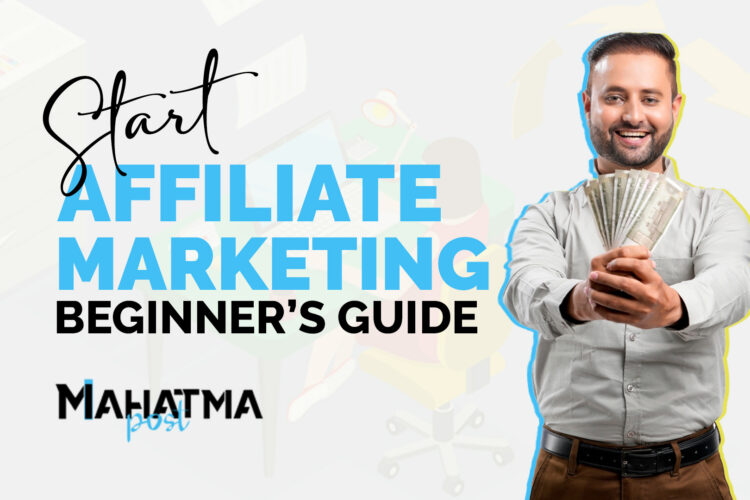Affiliate marketing is an excellent way to generate passive income by promoting products or services and earning a commission for every sale made through your referral. It’s an attractive business model for beginners because it doesn’t require creating your own products or managing customer service. If you’re new to affiliate marketing, this guide will help you start with a step-by-step approach.
What is Affiliate Marketing?
Affiliate marketing is a performance-based marketing model where you promote someone else’s products or services in exchange for a commission when a sale is made through your unique affiliate link. Essentially, you’re a middleman connecting customers to businesses.
For example, when you share a product on your blog or social media, and someone buys it using your affiliate link, you receive a percentage of the sale. It’s a win-win because businesses get more customers, and you earn money without dealing with the logistics of selling the product.
- Low Start-Up Costs: You don’t need to develop your products or services. You only need a platform to promote them, such as a website or social media.
- Flexibility: Affiliate marketing can be done from anywhere, at any time. You’re your boss, so you set your schedule.
- Scalability: Unlike traditional jobs, affiliate marketing has no income ceiling. You can scale by increasing your traffic or promoting more products.
- Passive Income: Once you set up your affiliate links and content, you can earn money even when you’re not actively working.
Step-by-Step Guide to Starting Affiliate Marketing
Here are some step-by-step processes on starting affiliate marketing:
Step 1: Choose a Niche
Selecting a niche is crucial because it helps you target the right audience. A niche is a specific area of interest that you’ll focus on in your affiliate marketing efforts.
- Passion and Expertise: It’s important to choose a niche you care about. If you’re passionate about the topic, creating content and building trust with your audience will be easier. For example, if you’re into fitness, you can promote health-related products.
- Profitability: While passion is important, also consider the profitability of your niche. Some niches like technology, health, and finance are more competitive but have higher commission rates.
- Audience Demand: Your niche should have a sufficient audience interested in buying products. You can research audience demand using Google Trends, keyword research tools, or by checking out popular blogs or forums in that niche.
Step 2: Find Affiliate Programs
These are platforms where you can find a variety of affiliate programs in one place. Some companies run their affiliate programs. If there’s a product or service you use or love, check if they offer an affiliate program. You can usually find this in the website footer or under sections like “Affiliate Program” or “Partners.”
Step 3: Build a Platform
A website or blog is the most reliable platform for affiliate marketing. If you have a strong following on Instagram, YouTube, TikTok, or Facebook, you can use these platforms to promote affiliate links. Building an email list allows you to communicate directly with your audience.
Step 4: Create Valuable Content
Here are some content ideas:
- Product Reviews: Write detailed reviews on the products you’re promoting. Be honest and transparent about the pros and cons. People appreciate genuine opinions.
- How-to Guides: Create step-by-step guides or tutorials on how to use the products. These can help readers understand their value and encourage them to make a purchase.
- Listicles: List your favorite products or best tools in your niche. For example, “Top 5 Must-Have Kitchen Gadgets for Busy Moms.”
Step 5: Insert Affiliate Links
After creating valuable content, it’s time to insert your affiliate links. Be sure to add them naturally within your content.
- Blog Posts: You can add affiliate links in product reviews, comparison articles, or other relevant content.
- Social Media: Add affiliate links in captions, stories, or bio sections on platforms like Instagram or TikTok.
- Email Marketing: In your newsletters, you can embed affiliate links to recommended products and a compelling call to action.
Disclosure: Always disclose your affiliate relationships. It is required by law in many regions. You can use statements like “This is an affiliate link, meaning I may earn a commission if you purchase through it at no extra cost.”
Step 6: Drive Traffic to Your Content
Once you have content with affiliate links, the next step is to drive traffic. Without traffic, no one will see your affiliate links, and you won’t make any sales. Here’s how to drive more traffic:
- SEO (Search Engine Optimization): Optimize your content for search engines like Google. Use keywords related to your niche, create high-quality content, and build backlinks to your site to rank higher in search results.
- Paid Advertising: Running ads on platforms like Google or Facebook can effectively drive traffic to your affiliate offers. You can target specific demographics to ensure your ads reach the right audience.
Step 7: Track Your Results and Optimize
Track your results to see how well your affiliate marketing efforts are doing. Most affiliate programs have dashboards where you can monitor clicks, sales, and commissions. Here’s what to track:
- Clicks: How many people are clicking on your affiliate links?
- Sales: How many people are purchasing products through your links?
- Conversion Rates: The percentage of people who click your link and make a purchase.
- Earnings: How much you’ve earned in commissions.
Conclusion
Affiliate marketing is an excellent way to make money online, especially for beginners. It might take time to see significant earnings, but with patience, persistence, and the right strategies, affiliate marketing can be a rewarding way to earn passive income.
So, why wait? Start your affiliate marketing journey today and watch your efforts pay off!

